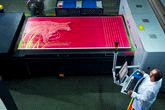Business News
Digital Printing Technologies Enable Serigrafia Pioner to Offer New Flexible and Rigid Products and Services

Tuesday 28. September 2010 - Established in 1965 as a traditional screen printer producing indoor and outdoor signage and graphics, Serigrafia Pioner has been steadily increasing its digital printing capabilities across its product range.
Challenge
Increase production speeds to meet customer demands for fast turn-arounds
Maintain print quality standards for customers, including international brands
Add digital rigid substrate printing capability
Develop new services for customers and add new revenue streams
Solution
HP Scitex FB7500 Printer
HP Scitex TJ8600 Printer
HP Scitex XP5100 Printer
HP Designjet 9000s Printer x 2
Results
Cost-effective, profitable short runs
Increased productivity
Print quality that can exceed screen printing
More formats possible and more products to meet customer requests
New revenue streams
Like the best dynamic businesses, Serigrafia Pioner, of Leganés, (near Madrid), Spain, keeps a close eye on both changes in the market and developments in technology.
Three years ago, the company installed an HP Designjet 9000s Printer for the production of backlit displays for its customers, including international brands.
“The printer produces top quality results,” said Javier Clemente, general manager, Serigrafia Pioner. “As the result of our experience with that machine, we looked at other areas where we could add digital production.”
Since then, Serigrafia Pioner has installed HP Scitex FB7500 Printer, and more recently the HP Scitex TJ8600 Printer and HP Scitex XP5100 Printer.
The FB7500 is designed for printing rigid and flexible sheets and uses UV-curable inks. With print speeds up to 500m2 per hour, the HP Scitex FB7500 Printer delivers the highest productivity of any digital flatbed printer in its price class.(1) HP Scitex X2 piezoelectric printheads maximise uptime and can be easily replaced and calibrated by the operator.
“We had looked at a number flatbed printers,” Clemente explained. “What we really liked with the HP Scitex FB7500 Printer was the quality/price ratio. After working with the machine for nine months now, we are really quite pleased with it. For certain types of work, conventional screen printing cannot compete with digital.
“There are other benefits, too: the new printer has enabled us to carry out projects we could not do before. Our screen machines are 1.80 x 1.20m, and the FB7500 can print up to 3.2 x 1.65m,” Clemente continued. “We save on costs because we don’t have to prepare screens and make the stencil films for each colour, or mix the inks – screen printing doesn’t use the PANTONE Colour system, so you have to mix colours yourself – it all takes time. Our single FB7500 does in one hour what used to take several hours and four screen machines.”
Growth opportunities
Serigrafia Pioner’s digital capability has enabled the company to develop its services and take on work that was previously not profitable.
“With a digital capability for both rigid and flexible substrate work, we can now take on jobs in areas where we weren’t competitive before, but really, nobody else was either, because the technology wasn’t available,” Clemente said. “This benefitted the customers because it used to be common for the designers to think up jobs that couldn’t be printed with screen. With digital printers, we can do them, and at a reasonable cost to the customer. The artwork arrives on a CD or is sent over the internet and we can start printing in five minutes.”
One of Serigrafia Pioner’s main customers is El Arbol, a supermarket with more than 420 stores in Spain. The shops comprise between 600 and 1400m2 and the company recently changed its image branding and asked Serigrafia Pioner to print the graphics and signage.
“The image change applied to everything, including the signs inside, the signs outside, vinyl images on the display windows and the signs in every section: deli, fish, wine, meats, and so on,” Clemente explained. “There’s also a backdrop that we made of Forex and Dibond, which is like aluminium.
“All the formats are very different from each other, but with the FB7500, we enter the format we want, print the image, take it to the shop and stick it to the wall with silicone,” Clemente said. “It’s a very, very easy task for the HP Scitex FB7500 Printer, and I have to say that to do this conventionally would have been absolutely impossible in terms of time and costs. We are fortunate enough to be getting exclusive monthly campaigns for single-post canvas billboards. I think that the FB7500 printer is the best machine in its sector.”
Continuing investment
Serigrafia Pioner continued to invest in digital technology, acquiring an HP Scitex TJ8600 Printer in April:
“It’s the first HP Scitex TJ series UV printer to be installed in Iberia and is very impressive, it can handle paper, vinyl and canvas,” said Clemente.
Most recently, Serigrafia Pioner invested in an HP Scitex XP5100 Printer, a 5m (16.4ft), 8-colour printer.
“I have an old 5m solvent ink machine that prints between 40 – 50m2 per hour, but our new HP Scitex XP5100 Printer prints 100 – 120m2 per hour,” Clemente continued. “What you need today is speed. Until recently, we all went home at 6pm, but now we’re open 24 hours, including Saturdays and Sundays.
“The workflow is constant: you get a job at 4pm for 10am the following day. So what do digital printers give me?” Clemente concluded, “I’d say they give me the speed that I need, and the speed that the market and my customers need.”
(1) Based on published manufacturer specifications as of July 2008.
